Articles Menu
It is so quiet on the banks of the Shubenacadie you can almost hear the river breathe.
Standing by the Treaty Truckhouse with Rachael Greenland-Smith and Dale Poulette, the instinct is to fall silent. The landscape draws you in with elemental power — an Alex Colville painting come to life.
Blue sky above, tawny long grass below, all of it bisected by the reddish tidal waters of the Shubenacadie. The only sound is the flapping of the Indigenous Unity flag when the wind picks up from the river.
The RCMP didn’t want any flags flying on nearby Treaty Island, but Mi’kmaq water protectors felt they had no choice. They believed that the Alton Gas company’s storage project, which would dump huge amounts of brine into the Shubenacadie, would endanger the river.
The company wants to build massive underground caverns to store natural gas. It would use river water to flush out salt deposits at a site 12 kilometres away, creating the caverns. The salty water would then be pumped back into the river over a few years.
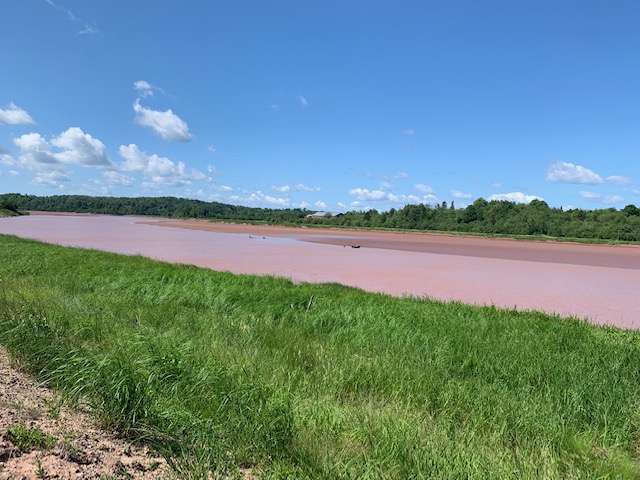 The reddish tidal waters of the Shubenacadie. Photo by Michael Harris.
The reddish tidal waters of the Shubenacadie. Photo by Michael Harris.
“We had to do something, because what they are doing is illegal,” says Poulette. “The federal Fisheries Act says you can’t dump ‘deleterious material’ into water where fish live. That is what they plan to do.”
And what is deleterious material? Here’s how the Fisheries Act defines it.
“Any substance that, if added to any water, would degrade, or alter, or form part of a process of degradation or alteration of the quality of that water so that it is rendered, or is likely to be rendered, deleterious to fish or fish habitat, or the use by man of fish that frequent that water.”
Since it launched the project in 2007, the company has always maintained that its activities on this project will be within all regulations, including the protection of marine life.
After more than a decade of controversy in this pristine region of rural Nova Scotia, it comes down to this: can “water protectors” like Poulette and Greenland-Smith win a war against governments and a resource company over the future of a grand river and the people it helps to sustain?
In these corporate and partisan days, when courts dispense a lot of law but not much justice, the odds are against a victory. But those odds got a little better for the water protectors after actor and Academy Award nominee Ellen Page threw her celebrity into the mix with a new claim: what Alton Gas plans to do with the support of both Ottawa and the government of Nova Scotia is an act of “environmental racism.”
Page explains how black and Indigenous communities in Nova Scotia, and elsewhere, are adversely affected by corporate activities, including the placement of facilities like dumps and polluting industries. She claims that poor and minority communities are targeted for projects that bring bad economic and health effects. Women often bear the brunt of those consequences — and lead the opposition to them.
“In Nova Scotia, there is a clear pattern that has gone on forever,” says Page, who was born and raised in Halifax. “The powerful invade lands to extract resources, grandmothers resist and they get arrested. Canada is infringing on Indigenous land, and not honouring treaty rights.”
Page and her co-director Ian Daniel are making a soon-to-be-released documentary film about this subject, There’s Something in the Water. It has just been accepted by the Toronto International Film Festival and includes the Alton Gas project. The film is titled after the book by Ingrid Waldron of Dalhousie University. Page was deeply impacted by what she read.
“It was upsetting and infuriating. What can I say? It taught me so much, opened my eyes in a profound way. I was blown away by the book. It was good to connect with her and amplify her work.”
Page was also inspired by Joan Baxter, the author who has written the definitive book on another environmental disaster in Nova Scotia that has impacted the Indigenous community for 50 years — the terrible pollution at Boat Harbour. What was once an estuary teeming with life is now a dead body of water after years of receiving toxic effluent from the local pulp mill.
So what exactly is going on in Alton, Nova Scotia, that brought a movie star to Greenland-Smith and Poulette’s door, and to the writings of Joan Baxter?
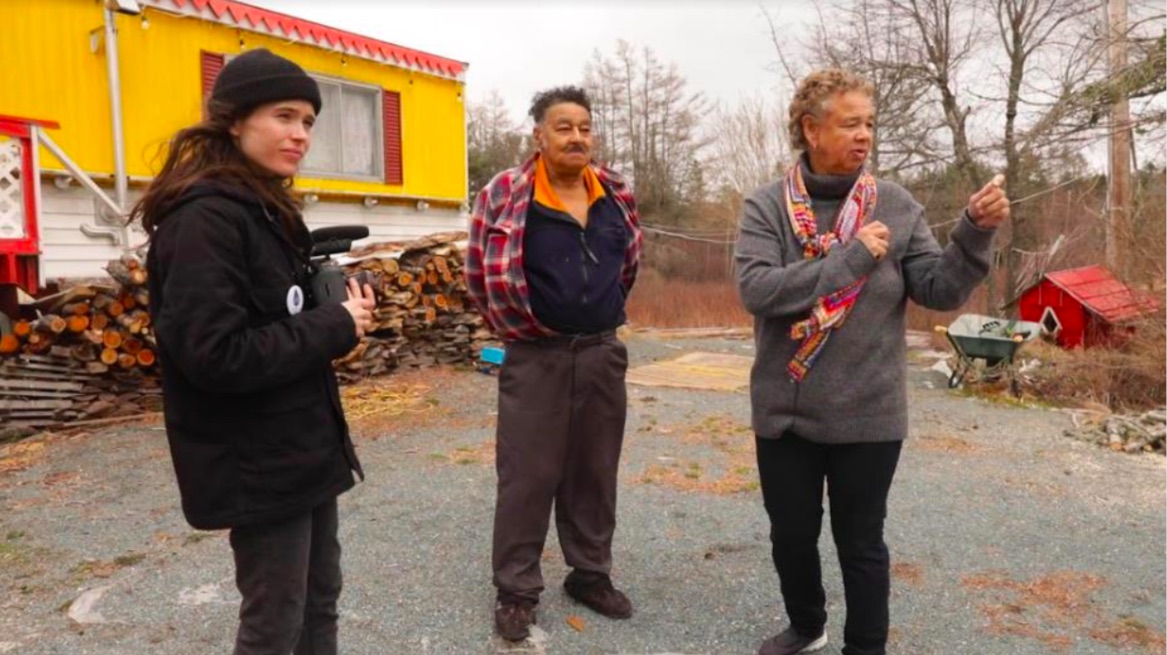 Actor and Academy Award nominee Ellen Page during the filming of soon-to-be-released documentary film There’s Something in the Water.Still from There’s Something in the Water.
Actor and Academy Award nominee Ellen Page during the filming of soon-to-be-released documentary film There’s Something in the Water.Still from There’s Something in the Water.Nothing short of the classic collision between resource development and environmental protection that is playing out all across Canada. In most cases, the developers win.
Some, like Prime Minister Justin Trudeau, call that part of a transitional road to a better place. Others see it as a cop-out, an alliance of government and corporations to keep the powers behind the status quo securely in the driver’s seat, while turning on the environmental charm just long enough to ease concerns.
As in many other places, there is another piece to this story: Indigenous rights.
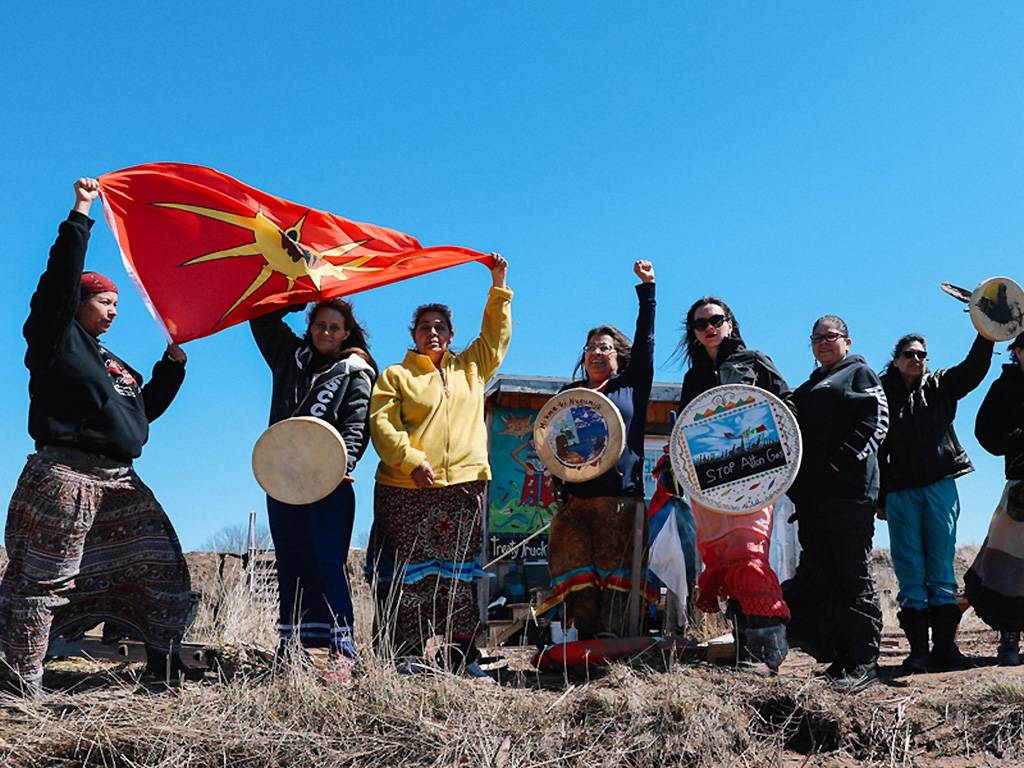 Water protectors hold the Indigenous Unity flag up in the wind. Still from There’s Something in the Water.
Water protectors hold the Indigenous Unity flag up in the wind. Still from There’s Something in the Water.The project is playing out on traditional, unceded Mi’kmaq territory. It does not have the support of the band most affected by it, the Sipekne’katik First Nation, though a few chiefs from other nearby reserves have flip-flopped on the proposal. Those Mi’kmaq opposing the project are asserting their rights based on the Peace and Friendship Treaties of the 1700s.
If the Shubenacadie River is damaged, it will be both an environmental disaster and a travesty of treaty rights.
The company’s plans
In the process that Alton Gas has developed, water is used to dissolve naturally occurring salt deposits to form immense caverns where natural gas will be stored.
Alton Natural Gas Storage (Alton Gas), a subsidiary of Calgary-based Alta Gas, wants to engineer caves from salt deposits located 700 metres below the surface.
The water to carve out the caves will be drawn from the Shubenacadie River and sent by buried pipeline to the salt formation 12 kilometres away at the community of Brentwood. Drilling for the first few caverns in this $130-million project has been completed. The company plans to create multiple storage caves, each resulting in a massive amount of salt water.
The company’s plan is to store billions of cubic feet of natural gas during periods of low demand, and then deliver it to a gas pipeline system during when demand is high. But the project drags a scorpion’s tail behind it. Where will all that briny water go?
Back into the river, which is home to striped bass, American eel, the endangered Atlantic salmon and other species.
Despite environmental clearances and other permits obtained by Alton Gas for its discharge facility, it is a dubious proposition for the Indigenous community.
The company says it will draw water from the estuary to dilute the briny mining solution in a “mixing channel” before releasing it back into the 73-kilometre-long Shubenacadie. The treated effluent would be discharged twice a day at high tide when salt levels are highest in the river. At least that’s the plan.
The company also claims the diluted brine will be “within the range” of salinities normally found in the estuary. The Shubenacadie is a tidal river, where some level of brackishness is present. Alton Gas says that with these twice-daily discharges, it will take two or three years to return all of the diluted mining brine back into the river.
But the briny water used to carve the salt caverns will have a salinity level of up to 260 parts per thousand (PPT) when it is discharged into the dilution channel — a deadly number. According to Environment Canada, 40 parts per thousand can be toxic to some fish species.
Dale Poulette says minnows, pinfish and other marine life that find their way into the mixing channel will be blasted by 260 PPT of undiluted brine. That would be a death sentence.
The company says the brine will be diluted so it has a salt content of 28 parts per thousand before it’s released into the river, which it says would do no “significant” damage to the river, the aquatic life it supports, or the people who catch and eat fish there.
But Poulette, for one, isn’t buying the company’s assurances that it can get the level that low.
“We even had a meeting with Nova Scotia environment officials,” he said. “They wouldn’t tell us the PPT of the effluent going back into the river. They said, ‘We won’t know until mining starts.’ It’s a big gamble. They shouldn’t be gambling with our water.”
Not backing down
Poulette is a Mi’kmaq from Eskasoni Reserve Number 3 in Cape Breton. When he first saw the Alberta oil sands, where he had travelled to work, his heart sank. “It looked like something out of a Freddy Krueger movie with all the stacks and pipes.” After three work-terms as a pipe and steam fitter, Poulette became ill with an abscess on his spleen.
“I prayed to the Spirit to let me live. I promised I would do no more harm to Mother Earth, and would help our people.”
An uncle flew out to Edmonton and brought Poulette home, where he recovered. When he was later asked by a group of Indigenous women called “Grassroots Grandmothers” to become a “water protector,” Poulette jumped at the chance. The grandmothers oppose the plan to dump brine in the Shubenacadie and “adopted” Poulette so that he could help defend the river on their behalf, he says.
For years he was in the company’s face, at first living in a straw and mud hut at the main entrance to the Alton Gas property.
The various structures Poulette occupied over the next two years were not five-star — mosquitoes in summer, cold in winter, and water sometimes knee-deep in the spring, when the Shubenacadie burst its banks and flooded places like the Treaty Truckhouse. A hammock to keep occupants off the damp floor, a small wood stove, and the cause were about all it had to offer.
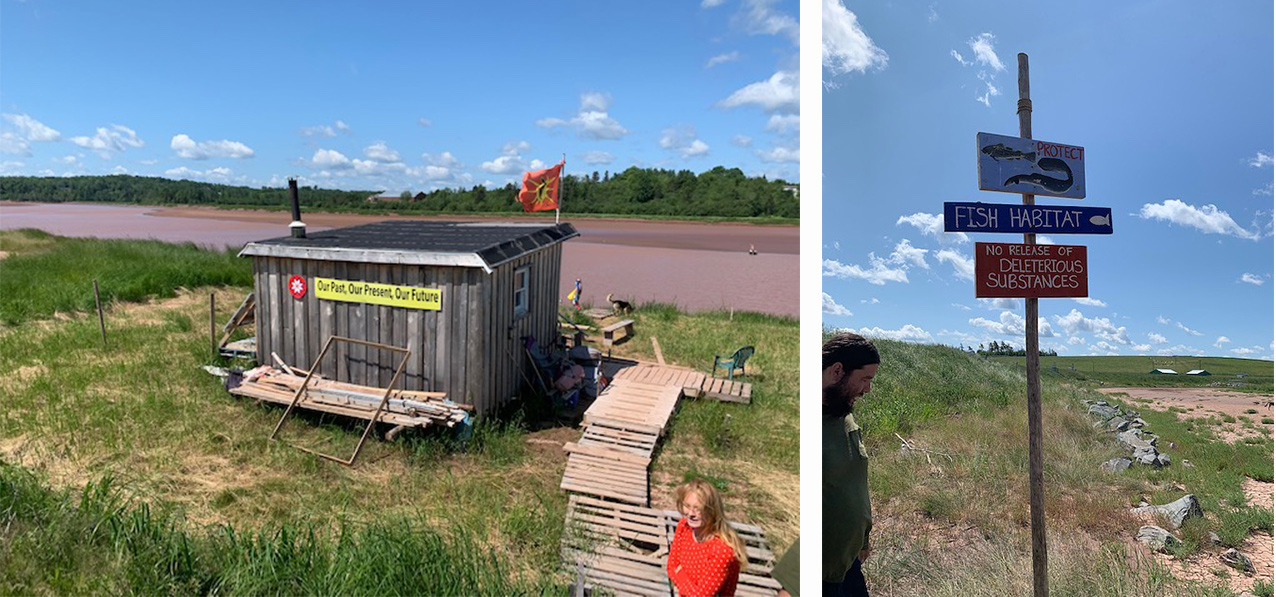 The Truckhouse (Left) and Mi’kmaq signs put up by water protectors (Right). Photos by Michael Harris.
The Truckhouse (Left) and Mi’kmaq signs put up by water protectors (Right). Photos by Michael Harris.In 2019, after years of controversy, including highway blockades by First Nations activists, the company sought an injunction against Mi’kmaq protesters at the straw and mud hut. Alton Gas argued that protesters were blocking the main access to the company’s pump house and control centre and impeding the movement of heavy equipment.
Lawyer Robert Grant represented Alton Gas in the application. He argued that the matter was cut and dry — a simple case of trespass on private property.
“Half of it is true, because white man’s law says so,” Poulette agreed. “But my law, my treaty law, says I have every right to be there. I have traditional rights. I have the treaty right to protect fish. The company came to court without clean hands, because their current plan is already against the law. We have exposed that. We have exposed that Environment Canada didn’t get all the information about what Alton Gas planned to do. That is work Rachael and I have done.”
In March 2019, Justice Gerald Moir granted Alton Gas its temporary injunction. The protesters, including Poulette and his partner Greenland-Smith, were evicted. In making his ruling, Moir said that there was “no basis in law” for the occupation by Mi’kmaq protesters.
Three members of the Grassroots Grandmothers defied the injunction — Doreen Gilbert, Madonna Bernard and Paula Isaac. Gilbert had already personally confronted Prime Minister Justin Trudeau over their cause:
“He told me that he would speak to the Grassroots Grandmothers. He never did. When the police came, they gave us a choice. Either leave or be arrested. I told them ‘I’m not afraid of going to jail for my land.’”
Their case is currently before the Nova Scotia courts.
A month after the judge’s ruling Alton Gas demolished the straw and mud hut. Under the terms of the temporary injunction, the company had to provide a place on its land where activists could engage in peaceful protests, but only during the day. The company complied, but confined protesters behind a fence festooned with signs prohibiting camping, fires, drugs and alcohol, Poulette says.
The judge also noted in his ruling that Poulette had been abusive to company employees and made threats against two of them. That reinforced the company’s contention that the situation at the protest site had become “combustible.”
I asked Poulette about the suggestion that violence was in the air at the company’s property.
“Absolutely not. Yeah, I swore at them. It took me two years to swear at them. Since we went to court, we’ve followed what the court has told us. They won their part of the injunction; we did not go back to that particular spot. No one has ever been violent at that site. I have never been arrested. Since then, all me and Rachael have done is meet with government, write letters, seek information, and educate people to what is happening here.”
The couple’s work, like that of many others opposed to the project, has been prodigious. Records gained during their personal vigil, as well as endless telephone calls, letters, and freedom of information requests now fill a binder the size of the New York City telephone book.
The pair has 13 new FOI requests that are outstanding and overdue. They are not going away as long as there is a politician to talk to, or a bureaucrat with documents who has knowledge of the project.
So why was the spectre of violence raised against people who had protested peacefully and never been arrested? Rachael Greenland-Smith has a theory: “These companies make protestors seem violent to deflect the fact that what they are doing is illegal.”
Ellen Page agrees.
“Companies and governments are doing the damage to people and the environment, and then they try to criminalize people who are doing the right thing. All these heroic people, often women, are trying to do is get governments to listen and help. Instead they’re oppressed. They shouldn’t have to be in that position.”
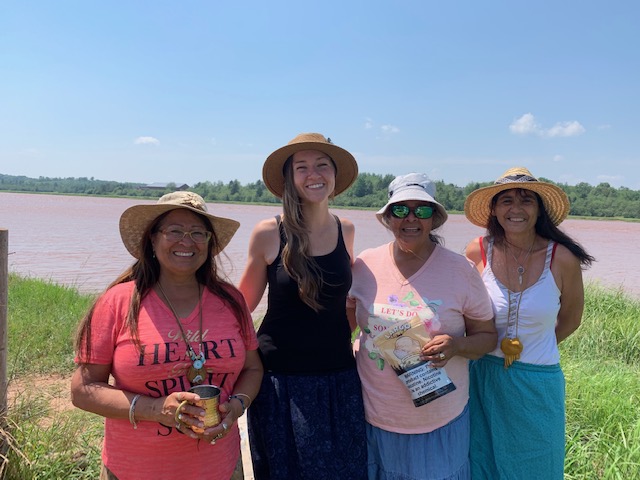 Water protectors stand by the Shubenacadie River. Photo by Michael Harris.
Water protectors stand by the Shubenacadie River. Photo by Michael Harris.Breaking the law, or not?
Poulette says he only protested to help people learn about the project, while the company and governments are the ones working behind closed doors and breaking the law.
“They plan to discharge that briny solution from mining out the caverns, they plan to discharge it at the riverside. Alton has intake and discharge pipes there. And their mixing channel is open and free-flowing to the river. Any animals can get through that channel. They are breaking the law and the treaty.”
Poulette’s assertion is supported by a noteworthy fact.
The federal government is currently drafting new regulations under Section 36(5) of the Fisheries Act governing the deposit of brine in the Shubenacadie River.
Ottawa says that the objective is to manage the risk of potential threats to fish, fish habitat, and human health — all laudable goals.
But Poulette wonders why would that be necessary if the company’s planned discharges into the Shubenacadie River complied with current law?
And if they don’t, and new compliance standards have to be developed, how did the project ever get environmental approval from government in the first place? The water protector smells a rat.
“New regulations from DFO are for one purpose and one purpose only: to make ‘illegal’ legal,” says Poulette.
The language of Ottawa’s “notice of intent” with respect to these regulatory changes suggests two things. They are tailor-made for the Alton Gas project; and they are an exception to the law as it now stands.Strong words, but worth thinking about.
Here is what Environment and Climate Change Canada had to say:
“The regulations under consideration would apply only to the substance and activity within the scope outlined above [the Alton Project]. Any other deposits would remain subject to the general prohibition in Subsection 36(3) of the Fisheries Act, including any deposits made within the anticipated scope of the project before such time as the proposed legislation comes into force.”
In other words, special regulations would exempt the project from the act’s general requirement that “no person shall deposit or permit the deposit of a deleterious substance of any type in water frequented by fish.”
The new regulations are to be published in the Canada Gazette at some point this year. When that happens, the public will get its chance to respond.
Unresolved questions
Whatever the eventual outcome of this cultural and environmental standoff, the government of Nova Scotia comes off looking like a colonial-era dinosaur.
The Nova Scotia Utility and Review Board approved construction extensions for the project, despite the reasonable and as yet unresolved allegations that it violates the federal Fisheries Act. The board’s explanation that it has no jurisdiction over environmental issues doesn’t provide much comfort.
And former Nova Scotia environment minister Margaret Miller decided in 2019 that the provincial government had consulted enough with the Sipekne’katik First Nation, and it was time to get the project going.
How can the ex-minister say it was time to stop talking about Alton Gas before the government received the “social licence” from the First Nations people most affected by it? Arresting three Grassroots Grandmothers at the site last April was hardly a confidence builder.
“Whatever they say, they are arresting grandmothers, not trouble-makers,” Poulette says. “Why can’t a grandmother stand somewhere and say, ‘I am not being violent, but I’m here to say I’m concerned about Mi’kmaq rights, the salmon, and a river that has been important to us for thousands of years?’”
Whatever you may think of their cause, First Nations protesters are more than entitled to see the Nova Scotia government as the compliant partner of Alton Gas, with nothing more than a token interest in Indigenous concerns.
The proof?
Just three years ago, when opposition to the project was building in Indigenous communities, the Sipekne’katik First Nation launched a lawsuit arguing the government had failed in its duty to consult with them on the project.
The provincial government produced a unique defence. Then provincial Crown lawyer Alex Cameron argued that the provincial government only had a duty to consult with “unconquered peoples.”
The gobsmacking implication of those words was clear: The Sipekne’katik were a “conquered people” and as a result there was no duty to consult. A wave of shock and anger swept over the First Nation most intimately involved, and roiled the ranks of Nova Scotia’s chiefs. Grassroots Grandmother Dorene Bernard was in court the day the Crown lawyer made his claim.
“It was like a punch in the stomach, a hard punch,” she recalled.
Since that outrageous argument was made, the province has refused to apologize. It has withdrawn the argument, claiming Cameron was acting on his own without direction from the government.
Cameron is now suing the government of Premier Stephen McNeil for defamation, constructive dismissal and violations of his Charter Rights.
The premier’s tactics in this lawsuit have been dubious. So far, the McNeil government has refused Cameron access to internal government documents he needs to make the case that he did not act alone in the “unconquered people” argument. If Cameron truly acted on his own, then the documents would prove that.
So why won’t McNeil release them?
After losing in two courts in Nova Scotia (one judge called the government’s arguments to seal the relevant documents “hollow” and “spurious”), the McNeil government petitioned the Supreme Court of Canada to keep the information from being made public on July 18. The Supreme Court of Canada obliged, “staying” the matter for the time being.
So once again, Indigenous people have to hunker down and wait for governments they believe oppress them to make a decision that profoundly affects their lives. The colonial ghost has risen from the Shubenacadie.
Dale Poulette is closer to despair than hope, but still defiant.
“I’d like to think that the federal government will make things better. But I fear that they’re going to use Alton Gas as a precedent. I think they’re going to move from this to open up fracking. Then they’ll use what happened here to dump their stuff into the river. That’s why we have to keep holding them to account.”
Ellen Page admires what she calls the “heroism and dedication” of people like Poulette and Greenland-Smith, who have fought in the shadows against much more powerful forces to protect “Mother Earth.”
“I want them to be heard. Their voices are the ones we need to be listening to. The reality right now, if you have privilege of any kind, is you have to be active; you have to stand up. We’re on the brink of extinction, and the levels of inequality between people is totally unacceptable. I want the ones left behind to be heard. I want them to have justice.”
Before I leave the Treaty Truckhouse, one of the Grassroots Grandmothers leads me down to the river. The wind is picking up, signalling that the tidal bore is on the way. In a haunting voice, like wind chimes rustling in the breeze, Doreen Bernard sings the Water Song in a language I do not understand. She translates for me.
“We thank you, we love you, we respect.”
Standing on the hillside, black-clad security guards for Alton Gas observe the activity at the Treaty Truckhouse. They can see Doreen Bernard, but are too far away to hear her song.